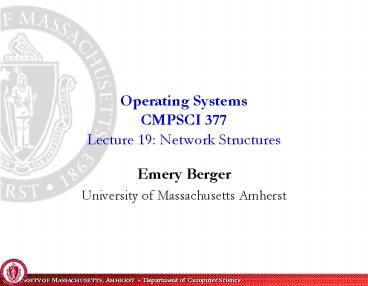Emery Berger - PowerPoint PPT Presentation
Title:
Emery Berger
Description:
Operating Systems CMPSCI 377 Lecture 19: Network Structures Emery Berger University of Massachusetts Amherst Next Few Classes Networking basics Distributed services e ... – PowerPoint PPT presentation
Number of Views:66
Avg rating:3.0/5.0
Title: Emery Berger
1
Operating SystemsCMPSCI 377Lecture 19 Network
Structures
- Emery Berger
- University of Massachusetts Amherst
2
Next Few Classes
- Networking basics
- Distributed services
- e-mail, www, telnet
- Distributed operating systems
- Distributed file systems
3
Distributed Systems
- distributed system set of physically separate
processors connected by one or more communication
links - no shared clock or memory
- Many systems today distributed in some way
- e-mail, file servers, network printers, remote
backup, web...
P2
P1
P4
P3
4
Parallel vs. Distributed Systems
- Tightly-coupled systems parallel processing
- Processors share clock, memory, run one OS
- Frequent communication
- Loosely-coupled systems distributed computing
- Each processor has own memory, runs independent
OS - Infrequent communication
5
Advantages of Distributed Systems
- Resource sharing
- Computational speedup
- Reliability
- Communication
6
Advantages of Distributed Systems
- Resource sharing
- Resources need not be replicated
- Shared files
- Expensive (scarce) resources can be shared
- Color laser printers
- Processors present same environment to user
- Keeping files on file server
7
Advantages, continued
- Computational speedup
- n processors n times computational power
- SETI_at_home
- Problems must be decomposable into subproblems
- Trivial embarrassingly parallel
- Coordination communication required between
cooperating processes - Synchronization
- Exchange of results
8
Advantages, continued
- Reliability
- Replication of resources provides fault tolerance
- One node crashes, user works on another one
- Performance degradation but system available
- Must avoid single point of failure
- Single, centralized component of system
- Example central file servers
9
Advantages, continued
- Communication
- Users/processes on different systems can
communicate - Mail, transaction processing systems like
airlines banks, www
10
Distributed Systems Issues
- Operating systems support for distribution
- Communication networks
- Transparency
- Security
- Reliability
- Performance scalability
- Programming models
11
Networks
- Goal provide efficient, correct, robust message
passing between two separate nodes - Local area network (LAN) connects nodes in
single building, fast reliable (Ethernet) - Media twisted-pair, coax, fiber
- Bandwidth 10-100MB/s
- Wide area network (WAN) connects nodes across
large geographic area (Internet) - Media fiber, microwave links, satellite channels
- Bandwidth 1.544MB/s (T1), 45 MB/s (T3)
12
Network Topologies
- Connection of nodes impacts
- Maximum average communication time
- Fault tolerance
- Expense
- Two basic topologies
- Point-to-point
- Bus
13
Point-to-Point Network Topologies
- Fully-connected
- Each message takes one hop
- Node failure no effect on communication with
others - Expensive impractical for WANs
14
Point-to-Point Network Topologies
- Partially connected
- Links between some, but not all nodes
- Less expensive, less tolerant to failures
- Single node failure can partition network
- Sending message takes several hops
- Needs routing algorithms
15
Point-to-Point Network Topologies
- Tree structure network hierarchy
- Messages fast between direct descendants
- Max message cost?
- Not failure tolerant
- Any interior node fails network partitioned
16
Point-to-Point Network Topologies
- Star network all nodes connect to central node
- Each message takes how many hops?
- Not failure tolerant
- Inexpensive sometimes used for LANs
17
Point-to-Point Network Topologies
- One-directional ring
- Given n nodes, max hops?
- Inexpensive
- Fault-tolerant?
18
Point-to-Point Network Topologies
- Bi-directional ring
- Given n nodes, max hops?
- Inexpensive
- Fault-tolerant? One node? Two?
19
Point-to-Point Network Topologies
- Doubly-connected ring nodes connected to
neighbors one more distant - Given n nodes, max hops?
- Fault-tolerant?
- More expensive
20
Bus Network Topologies
- Bus nodes connect to common network
- Linear bus single shared link
- Nodes connect directly to each other via bus
- Inexpensive (linear in of nodes)
- Tolerant of node failures
- Ethernet LAN
21
Bus Network Topologies
- Ring bus single shared circular link
- Same technology tradeoffs as linear bus
22
Principles ofNetwork Communication
- Data broken into packets
- Basic unit of transfer
- Packets sent through network
- Computers routers at switching points control
packet flow - Road analogy
- Packets cars
- Network roads
- Computer traffic lights (intersection)
- Too many packets on shared link/node traffic jam
23
Communication Protocols
- Protocol agreed-upon rules for communication
- Protocol stack layers that comprise networking
software - Each layer N provides service to layer N1
24
Traditional Layers
- Application layer applications that use the net
- Presentation layer data format
conversion(big/little endian) - Session layer implements communication
strategy(e.g., RPC) - Transport layer reliable end-to-end
communication - Network layer routing congestion control
- Data link control layer reliable point-to-point
communication over unreliable channel - Physical layer electrical/optical signaling
across wire
25
TCP/IP Protocol Stack
- Internet standard protocol stack
- TCP reliable protocol packets received in
order - UDP (user datagram protocol) unreliable
- No guarantee of delivery
26
Packet Format
- Contains all info needed to recreate original
message - Packets may arrive out of order need sequence
number - Data segment contains headers for higher protocol
layers application data
27
Summary
- Virtually all computer systems contain
distributed components - Networks connect them
- Key tradeoffs
- Speed
- Reliability
- Expense































